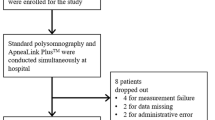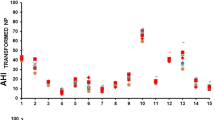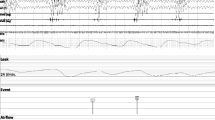Abstract
Objective
The purpose of this study was to compare the performance of the automated detection versus the manual scoring from the ApneaLink™ device to diagnose obstructive sleep apnoea syndrome (OSAS).
Methods
All participants (96) performed the ApneaLink™ (AL) and polysomnography (PSG) simultaneously in the sleep laboratory. The two recordings were interpreted blindly. The hypopnoea criterion used for the analysis of both automatic and manual ApneaLink™ was a fall in airflow ≥50% of baseline for ≥10 s. The agreement between AL and PSG and the interobserver concordance was calculated. ROC analysis, sensitivity and specificity were assessed for the different ApneaLink™ and OSAS criteria.
Results
Ninety patients were included (69 men; mean age, 49.6; median RDI, 13.9; median BMI, 29.3 kg/m2). The automatic apnoea/hypopnoea index (AHI-a) showed a lower agreement with the respiratory disturbance index (RDI) than the manual apnoea/hypopnoea (AHI-m) [AHI-a/RDI: intraclass correlation coefficient (ICC) 0.88 versus AHI-m/RDI: ICC 0.91]. The manual scoring (MS) showed a similar sensitivity and a higher specificity than the automatic scoring (AA) for the detection of OSAS, defined as an RDI ≥ 5 (sensitivity and specificity AA and MS: 89%/89%, 60%/86.7%, respectively). The accuracy of the automatic and manual scoring of the AL was similar when OSAS was defined as an RDI ≥ 20 or 30. The ApneaLink™ manual scoring had a very good interobserver agreement (k = 0.86).
Conclusions
The manual scoring of an ApneaLink™ recording was better than the automatic scoring in terms of agreement with RDI and to discriminate patients with OSAS. The hand scoring did not improve the accuracy of automatic scoring in patients with severe OSAS.




Similar content being viewed by others
References
Koziej M, Cieslicki JK, Gorzelak K, Sliwinski P, Zielinski J (1994) Hand-scoring of MESAM 4 recordings is more accurate than automatic analysis in screening for obstructive sleep apnoea. Eur Respir J 7:1771–1775. doi:10.1183/09031936.94.07101771
Esnaola S, Duran J, Infante-Rivard C, Rubio R, Fernandez A (1996) Diagnostic accuracy of a portable recording device (MESAM IV) in suspected obstructive sleep apnoea. Eur Respir J 9:2597–2605
Calleja JM, Esnaola S, Rubio R, Duran J (2002) Comparison of a cardiorespiratory device versus polysomnography for diagnosis of sleep apnoea. Eur Respir J 20:1505–1510
Golpe R, Jiménez A, Carpizo R (2002) Home sleep studies in the assessment of sleep apnea/hypopneas syndrome. Chest 122:1156–1161
Dingli K, Coleman EL, Vennelle M, Finch SP, Wraith PK, Mackay TW, Douglas NJ (2003) Evaluation of a portable device for diagnosing the sleep apnoea/hypopnoea syndrome. Eur Respir J 21:253–259
Collop NA, Anderson WM, Boehlecke B, Claman D, Goldberg R, Gottlieb DJ, Hudgel D, Sateia M, Schwab R (2007) Clinical guidelines for the use of unattended portable monitors in the diagnosis of obstructive sleep apnea in adult patients. Portable monitoring task force of the American Academy of Sleep Medicine. J Clin Sleep Med 3:737–747
Wang Y, Teschler T, Weinreich G, Hess S, Wessendorf TE, Teschler H (2003) Validation of microMESAM as screening device for sleep disordered breathing. Pneumologie 57:734–740
Erman MK, Stewart D, Einhorn D, Gordon N, Casal E (2007) Validation of the ApneaLink for the screening of sleep apnea: a novel and simple single-channel recording device. J Clin Sleep Med 3:387–392
Chen H, Lowe AA, Bai Y, Hamilton P, Fleetham JA, Almeida FR (2009) Evaluation of a portable recording device (ApneaLink) for case selection of obstructive sleep apnea. Sleep Breath 13:213–219
Ragette R, Wang Y, Weinreich G, Teschler H (2010) Diagnostic performance of single airflow channel recording (ApneaLink) in home diagnosis of sleep apnea. Sleep Breath 14:109–114, PubMed PMID: 19714380
Nigro CA, Serrano F, Aimaretti S, Gonzalez S, Codinardo C, Rhodius E (2010) Utility of ApneaLink for the diagnosis of sleep apnea-hypopnea syndrome. Medicina (B Aires) 70:53–59
Ng SS, Chan TO, To KW, Ngai J, Tung A, Ko FW, Hui DS (2009) Validation of a portable recording device (ApneaLink) for identifying patients with suspected obstructive sleep apnoea syndrome. Intern Med J 39:757–762
Rechtschafen A, Kales A (1968) A manual of standarized technology, techniques and scoring system for sleep stages of human subjects. Brain Information Service, Los Angeles
American Sleep Disorders Association (1992) EEG arousals: scoring rules and examples: a preliminary report from the sleep disorders atlas task force of the American Sleep Disorders Association. Sleep 15:173–184
Masa JF, Corral J, Martín MJ, Riesco JA, Sojo A, Hernández M, Douglas NJ (2003) Assessment of thoracoabdominal bands to detect respiratory effort-related arousal. Eur Respir J 22:661–667
Ayappa I, Norman RG, Krieger AC, Rosen A, O’malley RL, Rapoport DM (2000) Non-invasive detection of respiratory effort-related arousals (REras) by a nasal cannula/pressure transducer system. Sleep 23:763–771
Consenso Nacional sobre el Síndrome Apneas-Hipopneas del Sueño del Grupo Español de Sueño. Definición y concepto, fisiopatología, clínica y exploración del SAHS (2005). Arch bronconeumol 2005; 41, Extraordinario 4: 12–29
Guilleminault C, Bassiri A (2005) Clinical features and evaluation of obstructive sleep apnea–hypopnea syndrome and upper airway resistance syndrome. In: Kryger MH, Roth T, Dement WC (eds) Principles and practice of sleep medicine, 4th edn. Elsevier, Philadelphia, pp 1043–1052
Sala H, Nigro C, Rabec C, Guardia AS, Smurra M (2001) Consenso Argentino de Trastornos Respiratorios Vinculados al Sueño. Medicina (B Aires) 61:351–363
Farré R, Rigau J, Montserrat JM, Ballester E, Navajas D (2001) Relevance of linearizing nasal prongs for assessing hypopneas and flow limitation during sleep. Am J Respir Crit Care Med 163:494–497
Pita Fernández S, Pértega Díaz S (2003) Pruebas diagnósticas. Cad Aten Prim 10:120–124
Acknowledgment
The authors wish to thank Ms. Jaquelina Mastantuono for revising the English text.
Conflicts of interest
We declare that there were no conflicts of interest related to this investigation.
Author information
Authors and Affiliations
Corresponding author
Rights and permissions
About this article
Cite this article
Nigro, C.A., Dibur, E., Aimaretti, S. et al. Comparison of the automatic analysis versus the manual scoring from ApneaLink™ device for the diagnosis of obstructive sleep apnoea syndrome. Sleep Breath 15, 679–686 (2011). https://doi.org/10.1007/s11325-010-0421-9
Received:
Revised:
Accepted:
Published:
Issue Date:
DOI: https://doi.org/10.1007/s11325-010-0421-9




